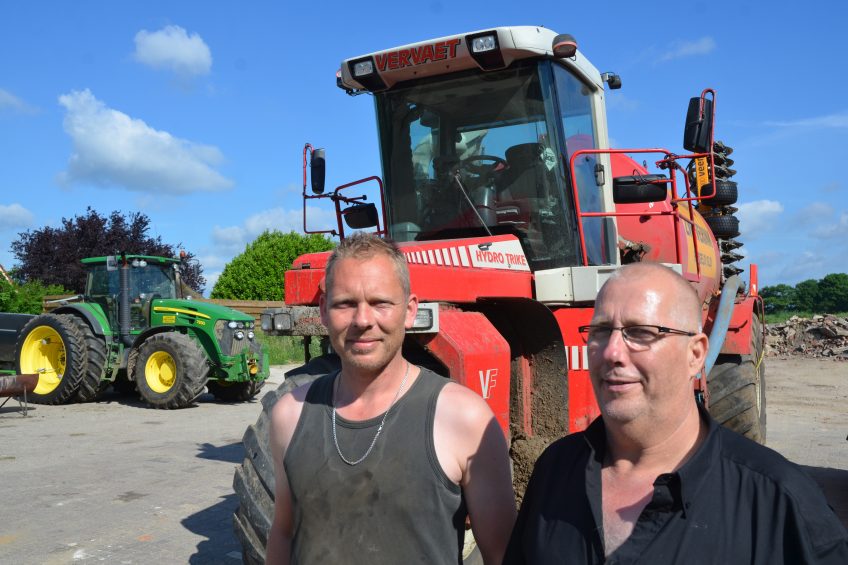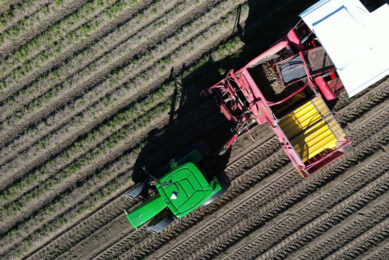Smart sensors make slurry application more accurate

Several Dutch contractors are working with a system that automatically calculates slurry nutrient values while injecting. Future Farming takes a look at the technology set to become an essential tool for increasing slurry application accuracy.
An estimated 70-75cu m of slurry is produced by Dutch livestock farms each year. New sensor technology is now available to help ensure it is applied to land as accurately as possible.
Slurry application is governed by strict rules in the Netherlands and all new techniques that can increase application accuracy, are scrutinised.
The latest technological development uses near-infrared (NIR) sensor technology, which paves the way to apply slurry in kg of N, P or K rather than a blanket treatment of cu m/ha.
Several Dutch slurry tanker makers, including Kaweco, Veenhuis, Vervaet and Vredo, are working with the new technology, and regardless of system, the NIR sensor is installed inside the slurry tank filling pipe or where it is pumped to the distributor.
A light beam within the same NIR sensor housing is directed into the pipe. Some of the light is absorbed by the liquid, while the reflected part is captured by the sensor.
The thousands of readings taken each second are relayed to a processor computer, which compares the information with a database to calculate a calibration model for the N, P and K content in kg/cu m.
The tanker’s slurry pump automatically adjusts the flow to deliver the pre-set required volumes of N, P or K or a maximum pre-set limit of each.
What are the benefits?
One obvious benefit of the technique is allowing farmers to know exactly how many kilogrammes of nitrogen or phosphate have been applied to their land (site-specific when combined with a GPS system), which could help them to reduce artificial fertiliser inputs.
It all sounds quite simple. However, the tricky part is that slurry nutrient contents not only varies between farms, but also within a pit.
It is a major challenge to collect the data and create the algorithms for the process computer to be able to take the information from the NIR sensor and translate this into accurate N, P and K values for the thousands of different slurry types.
As it is difficult for a company to do alone, Kaweco has teamed up with several manufacturers. The company is currently evaluating a handful of NIR-sensor machines and will show a system at Agritechnica in November.
Developed jointly with Eijkelkamp and MUT Electronics, one of the systems is installed on a Claas Xerion in Germany, the others on trailed tankers in the Netherlands.
Accuracy required
The hardware works, says the firm’s technical commercial manager, Rens Veeneman, but it needs more accuracy. “The computer displays N, P and K levels on the go, but the challenge is to get the accuracy of NPK in all types of slurry closest to 100%. “Updating the database is a never-ending process, because the composition of slurry changes depending on feed and weather,” he explains.
However, Mr Veeneman is certain NIR sensors on slurry tankers are the future, not just in the Netherlands, but in many other European countries.
“German contractors do not have to comply with strict slurry rules like the Dutch, but they are interested in NIR sensor technology. When you know a slurry’s nutrient content – the yield, soil type and so on – you can create a variable-rate treatment map. This can be uploaded to the slurry tanker to apply the required [amount of] N, P or K.”
This is the first season Vredo has supplied its machines NIR sensor-ready. The firm uses two systems – John Deere’s Manure Sensing System and German firm Zunhammer’s Van-Control 2.0.
The first customer, a contractor in southern Germany, opted for John Deere’s NIR sensor technology, which is packaged with this firm’s automatic GPS steering system. Installed on a 687hp VT7028-2, the NIR sensor is used to analyse slurry as it is pumped into the 21cu m tank.
“The customer knows how many kilogrammes of nitrogen a full tank contains, and then sets the application rate accordingly to apply a blanket treatment,” says Vredo’s slurry equipment sales and marketing manager, Adrie Kunst.
He reckons this is the way most contractors work. “The accuracy is not yet high enough to vary application rates on the move and a great deal of work is still needed to improve calibration curve accuracy,” he claims.
Recouping costs
Mr Kunst believes most Dutch and German slurry contractors are talking about NIR sensor technology, but a question they all find difficult to answer is how to recoup the investment costs.
“They need to think about how it improves their business model, otherwise we are selling them something they cannot make any money with.”
Nutriflow is the name of Veenhuis’ NIR sensor system. Now in its second season, the pre-production version is fitted to a contractor’s Vervaet trike. A second Nutriflow system is installed on one of Veenhuis’ single-axle 14,000-litre-capacity (3,700gal) trailed slurry tankers.
Currently in a Dutch university research project, one nutrient parameter can be selected, and the researchers have opted for phosphate. The system differs in that it is possible to add nitrogen fertiliser to the mix from a 1,500-litre (400 gal) capacity front-mounted tank.
Currently in year two of the three-year project, this season they are monitoring the effects of applying slurry variably from a field soil map. Also, they have begun measuring the harvested quantity of forage, both with a self-propelled forage harvester and self-loading wagon, paving the way to variable-rate applications.
- NIR sensor fitted in filling pipe to analyse slurry for N,P and K
- The tanker’s slurry pump automatically adjusts the flow to deliver set rate of nutrient kg/ha
- Trials looking at its use to deliver variable-rate applications according to nutrient maps
- Work ongoing as accuracy insufficient for on-the-move analysis
Could NIR sensor technology become a standard feature on slurry tankers in the future? It is a question that is difficult to answer.
The Dutch government is still not convinced that the technology is 100% reliable, but should accuracy levels increase, surely it can only be a matter of time before such systems become mandatory.
User story: Zweverink family, the Netherlands
Dutch firm Vervaet claims to have been one of the first to offer an NIR sensor on its self-propelled slurry machines. Today, there are a confirmed six Dutch users and one is the Zweverink family.
Run by father Theo and son Jochem, each season the contracting business injects about 90,000cu m (3.2mcu ft) of slurry – the majority into grassland.
The family has been a Vervaet customer since 1991 and runs two trikes – a 2009 machine with 10,000 hours on its clock and a 16cu m (565cu ft) capacity and new-style version, which arrived at the start of last season.
The new machine came fitted with John Deere’s Greenstar terminal, and the NIR sensor system was installed a few months later.
Except for the enclosed yellow casing housing the NIR sensor, there is nothing to see on the outside of the machine, and inside the cab the only visible evidence is on the Greenstar display.
Operator Mark Teunissen was given a bit of training, but reckons it is easy to program the system. It is only possible to select the required number of kg/ha of one nutrient – either N or P, but it is possible to set maximum values for the other.
If the nitrogen content of the slurry varies, the application rate is automatically increased or decreased to ensure the number of kilogrammes remains constant.
Slurry application
Costs vary from US$33,600-$44,800 for a guidance system and NIR sensor technology.
Zweverink already had the guidance system, and to add the NIR sensor technology left the two men with no change from $31,940, which they are obviously keen to recoup.
Theo admits it is still early days, and while the new machine has already done more than 2,000 hours, only a small number of these have been using the NIR sensor.
“Some of our customers are keen to apply accurate quantities of N, P and K, but few are prepared to pay the extra $0.28c/cu m to use the NIR sensor in these cost-conscious times,” says Theo.
Another issue is that farmers apply slurry in cu m/ha when they now need to think kg of nitrogen and phosphate a hectare. “This is not what they are used to and requires a different mindset.”
However, he is convinced the technique is the future. “We have to continue to invest in new technology. If we do not do it now, it will cost too much to catch up at a later stage.”
The next investment is on the horizon. While Zweverink can accurately apply the required kg of N or P, the fields in their area are small and irregularly shaped and overlapping is unavoidable.
When the time comes to change the Veenhuis injection kit, the replacement will almost certainly have section control.
Join 17,000+ subscribers
Subscribe to our newsletter to stay updated about all the need-to-know content in the agricultural sector, two times a week.



